The Hanoi Agricultural Extension Center in collaboration with the farmers has successfully grown blue dragon plants with red flesh on a barren hilly area in Hanoi, opening a new way of growing the plants.
The road in Kim Quan Commune (Thach That District, Hanoi) was shaded by blue dragon plants growing along both sides. When I entered the house owned by Do Xuan Nhung who was Secretary of the Communal Party Committee, I was amazed at the sight of hundreds of trellis of blue dragon plants which were sprouting strong buds. Talking about the farmers doing a good business, he eagerly told us a story about the dragon fruit with red flesh. Dragon plants usually grow on flat land and the mountain and coastal areas. In 2008, under the guidance of the agricultural engineers from the Hanoi Agricultural Extension Center, he boldly brought this plant, which was suitable to the natural conditions in the southern provinces, to grow on hilly land on a trial basis.
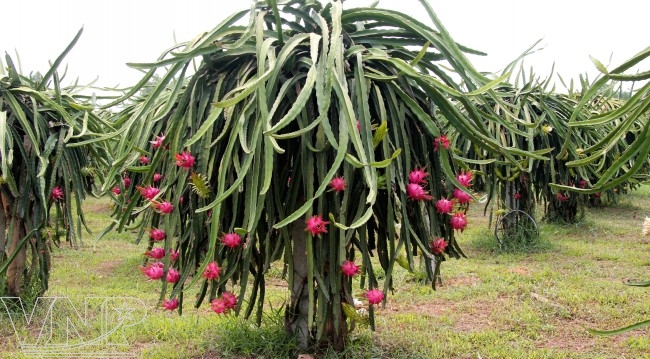
Blue dragon plants grow well on the hilly land.
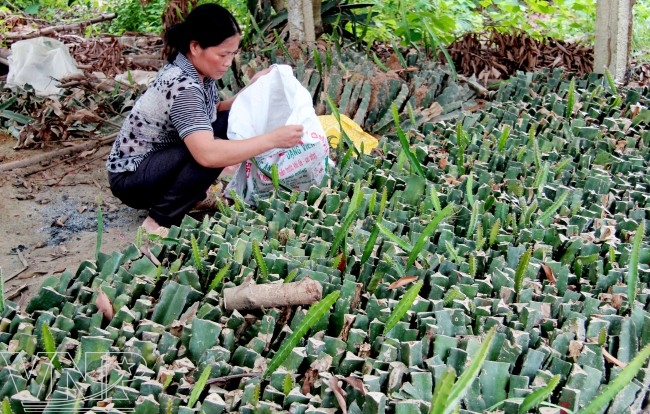
The seed garden of Do Xuan Nhung’s family.
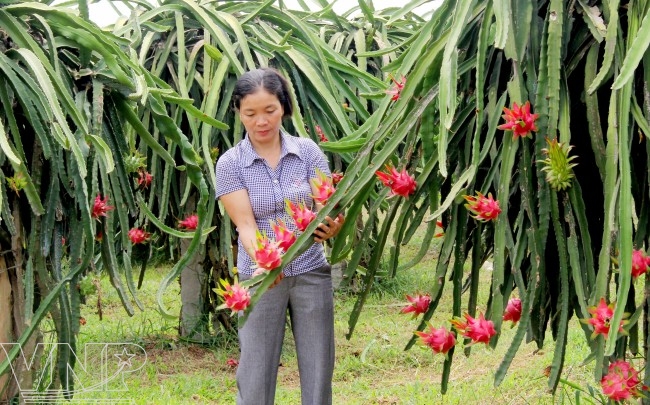
Nguyen Thi Hong, wife of Do Xuan Nhung, shows blue dragon fruit with red flesh that brings high productivity and economic value. |
«...
"From the initial results of the model of growing the blue dragon plants with red flesh we can affirm that these plants can grow well and have high output and economic value. We can expand the cultivation area on the hilly land, in accordance with the plan on concentrated fruit cultivation areas in Hanoi."
(Nguyen Van Chi, Director of Hanoi Agricultural Extension Centre)
|
He invested hundreds of millions of Vietnam dong in building a garden for the dragon plants. For a farmer it was a large investment which could be lost if the plant did not grow on the hilly land. After winning a contract to rent more than 10ha of the commune’s land, he planted 3,000 dragon plants in an area of 3ha. After two years, his garden had a high yield and was economically efficiency. From early April to late October according to the lunar calendar, on average, his family harvests dragon fruit 7-9 times, each time with 3-5kg of fruit/plant. A plant yields 15kg of fruit. Traders come to his garden to purchase the fruit at a price of 30,000 VND/kg. The economic value of this particular dragon fruit is 2-3 times higher than that of the white-flesh species. Ms. Oanh, a trader who purchases dragon fruit from Nhung’s garden said: “Dragon fruit with red flesh in this area is fresh for a long time so it needs neither preservatives nor freezing to store it. As a result, they are much sought after by consumers.”
Talking about the importance of the dragon fruit, Nhung said that unlike many other trees which need care, efforts and investment after harvest to prepare for a new crop, his dragon plants has an ever-increasing output in following years with less investment. The farmers harvest the fruit all year round and earn dozens of million dong per harvest after deducting expenses.
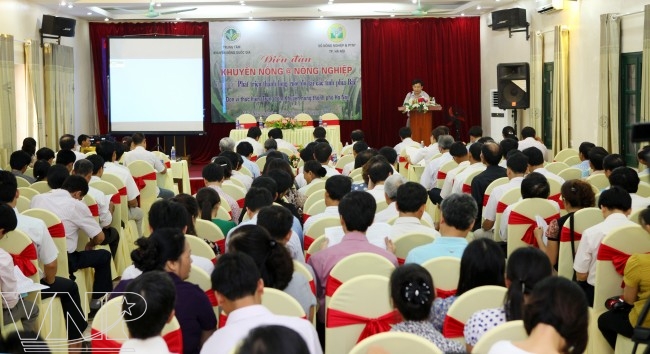
At the Agricultural Extension Forum held in Ba Vi District, Hanoi, the delegates discuss many issues relating to the development of the blue dragon plants in the northern provinces.
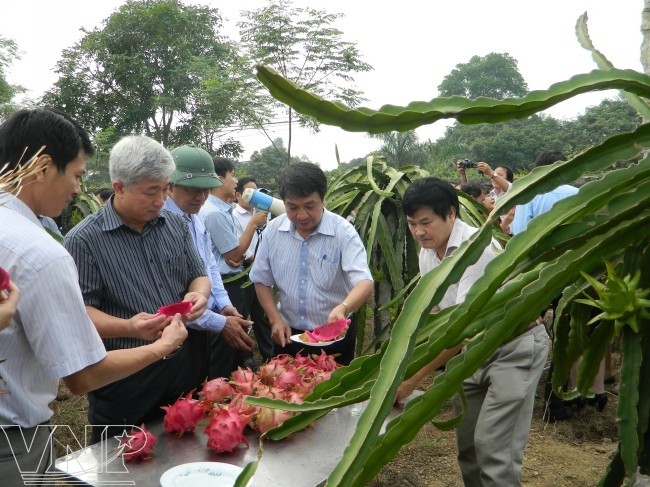
The delegates attending the Agricultural Extension Forum visit the 20ha-field of blue dragon plants in Cam Linh Commune, Ba Vi District, Hanoi.
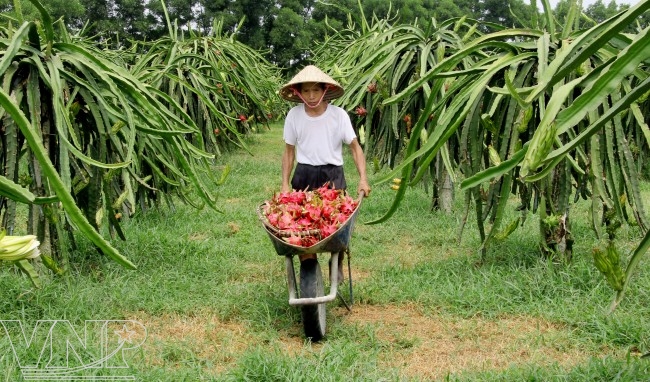
The harvest of blue dragon fruit lasts from early April to late October of the lunar calendar. |

Harvesting blue dragon fruit. |
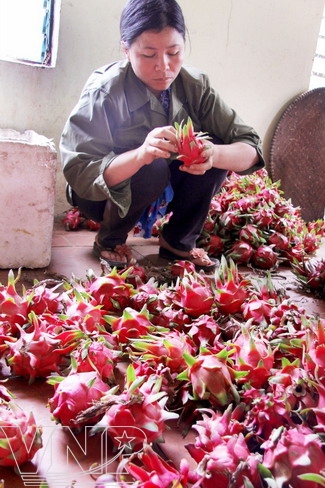
Classifying blue dragon fruit with red flesh before selling.. |
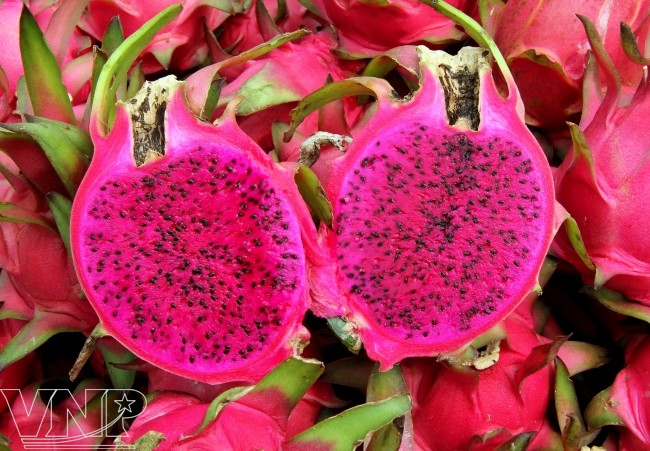
The blue dragon fruit with red flesh is rich in vitamins and nutrition. |
Nhung’s family is growing seedlings to sell to other households in the district. Many families that have hilly land have shifted from growing cassava to growing dragon plants. Hoang Ngoc Hap in Kim Quan Commune, Thach That District said: “After visiting Nhung’s family and studying their economic model, I decided to grow dragon plants on one hectare which was formerly a cassava garden. At that time the villagers said that I was taking a risk because the investment in growing that strange plant was huge, especially for a poor farmer. But after a year of harvesting the fruit, everyone praised my ‘venture’ which brought prosperity to my family.”
Now the hilly area under dragon plant cultivation in the outskirts of Hanoi is increasing. From now to the end of this year, the Hanoi Agricultural Extension Center will coordinate with Thach That District People’s Committee to grow this species of plant on 12ha of forest land in the hilly area of Kim Trung and provide assistance with capital, technique and variety for the households which have difficulties in growing the dragon plants, opening a promising path for a suburban agricultural area.
Story: Thao Vy - Photo: Trinh Van Bo
Story: Thao Vy - Photo: Trinh Van Bo